 |
| Ground plan for new theatre to be built this year at 651 Fulton Street, which would be the Majestic Theatre, still in operation as the BAM Harvey. |
By
Samuel L. Leiter
For comprehensive background on Brooklyn’s pre-20th-century theatre history please see my book, Brooklyn Takes the Stage: Nineteenth-Century Theater in the City of Churches (McFarland: 2024) and my blog, “Annals of the Brooklyn Stage.” The latter is a week by week description of theatre activity in Brooklyn; obviously, it will expand rather slowly because so much must be described and the present blog will be occupying my attention until live theatre in Brooklyn begins to fade over the early decades of the 20th century, dying out by the 1930s.
The entries in this blog began as annual ones, for 1898 and 1899. Because of the large amount of memory used, which made editing them problematic, subsequent entries were shortened so they covered only several months at a time, but these too needed to be shortened. Thus, beginning with 1901: September, all entries cover a single month. The quickest way to find any of these entries is probably to click on the following link, where links to everything prior to its date are provided: 1901: DECEMBER
For months in 1902 click here.
Some significant developments were on Brooklyn theatre
people’s minds in February 1903, not all of them immediately linked to
Brooklyn. One was the growing interest in serious drama, a natural outgrowth of
the predominance of theatrical fluff clogging people’s gray matter. There
seemed a movement afoot to bring Shakespeare back into prominence with spectacular
productions that illustrated his every hither, thither, and yon. Most obvious of
the examples was E.H. Sothern’s Hamlet, which he’d revived in lavish scenic
fashion after a merely ordinary earlier production, and Richard Mansfield’s
extravagant Julius Caesar, in which he portrayed Brutus. His recent
success with another gorgeous Shakespearean spectacle, Henry V, proved
to him there was box office gold in such seemingly risky ventures.
Hamlet still had not visited Brooklyn but Julius Caesar
would appear there this month, having just closed its moneymaking run in
Boston. Other A-listers rumored soon to be stepping up to the so-called serious
drama were Julia Marlowe (eventually to team with Sothern for an historic
partnership doing Shakespeare revivals), Louis Mann, Maude Adams, Mrs. Fiske, William
Gillette, and, notably, Mary Shaw, who had just impressed the New York intelligentsia
with a surprisingly effective revival of Ibsen’s Ghosts, seen only for a
brief, matinees-only engagement, and now going on the road.
In the Eagle of February 1, 1903, Hamilton Ormsbee reported on the striking of the Julius Caesar set at Boston’s
Colonial Theatre so it could be transported to Brooklyn’s Montauk. This was an epic
staging, with a cast of 300 filling out its crowd scenes, requiring unique
dressing room accommodations. Mansfield’s production traveled with its own “special”
calcium lights. “One feature of the list of things which had to be made ready,”
wrote Ormsbee, “is a block and tackle, with a raising capacity of 3,200
pounds. It is . . . raise a large section of the Senate scene, which is a remarkable
effect in amphitheater form, and must be strong enough to bear the crowd of
Senators.”
Sets and costumes for Mansfeld’s six-act, nine-scene script were
by leading artist Sir Alma Tadema, with particular scenes painted by Hawes Craven,
William Telbin, and Richard Marston. Despite its fame and popularity Julius
Caesar had not had a significant revival in the New York area in 15 years.
Ormsbee, on February 8, remained in awe of the success
found both locally and nationally over the past several years by the return of
stock companies, with subscription audiences even more enthusiastic than those
for grand opera. There were now six such troupes in Brooklyn, those at the Bijou,
the Columbia, the Gotham, Payton’s Lee Avenue, Payton’s Fulton Street, and
Phillips’ Lyceum. (This wasn’t that unusual in 1903, since Chicago had eight,
Philadelphia had six, Manhattan had four, and Boston had around the same.) He appreciated the occasional revival by several
of these companies of classic plays, sometimes led by outside actors in the
leads. The example he cites for the moment is Creston Clarke, now obscure, but
who enjoyed a brief flirtation with fame because he was the nephew of the great
Shakespearean star Edwin Booth, who died in 1893, two years after retiring in a
farewell performance at the Brooklyn Academy of Music. His father, John C. Clarke,
was a respected actor. Creston Clarke, said to bear some resemblance to Booth,
starred with the Columbia stock company in Hamlet, in which he was
reasonably acceptable.
Ormsbee praised the better stock companies for providing “adequate
performances” of plays that would have cost far more at the high-priced
playhouses, bringing popular-priced art to the masses, and thereby enhancing
their taste and knowledge, stimulating the desire for “a better drama.” “When
the day of the artistic, thoughtful theater really dawns in this country the
stock companies will be seen to have been its most efficient path breakers.”
Much was afoot this month regarding local playhouses. One,
opened in 1891 on Williamsburg’s South Sixth Street and Bedford Avenue as the Bedford
Theatre, had been forced to close, as noted in a previous entry, because its stage
area extended into the path to be taken for the soon-to-be built Williamsburg
Bridge. It was built just one year before the bill to build the bridge was
passed. The theatre, which had had an up-and-down career as a legitimate
playhouse before joining Brooklyn’s Hyde & Behman vaudeville empire as,
naturally, the Empire Theatre, was now going to be converted to a knitting
mill. For details on the sale, the theatre’s history, and other relevant facts,
see the Eagle, February 15, 1903.
More to our liking was the news of new theatres in the works.
The most important was the yet unnamed Majestic Theatre, noted in the January 1903
entry, at 651 Fulton Street, three doors up from Rockwell Place, and diagonally
across from the Orpheum, one of the borough’s biggest vaudeville houses. The
theatre’s body was to be on Ashland Place. As previously noted, it still stands,
122 years later, albeit with a deliberately distressed interior, as the BAM
Harvey, home to groundbreaking visiting productions, many from abroad.
At the time, its position as a parcel of real estate was
fraught, since the plans for the imminent construction of the proposed Flatbush
Avenue Extension, leading to the not-yet-built Manhattan Bridge (still called
Bridge No. 3) were not yet settled, and it was likely that the site stood a
block away—300 feet—from the extension’s path. “Every down town car line passes
the property,” said the Eagle, “excepting the Flatbush and DeKalb avenue
lines, and they are only one block distant.” While there was a frenzy to purchase
property near the site, many property owners were being cautious, waiting until
the Extension’s exact route was decided before selling.
Some thought the Montauk, on nearby Flatbush at Fulton,
would be forced to move (it was, dramatically, as we shall see in a later entry),
or be destroyed, and that this would be the new Montauk. More on what happened awaits
us in the future. There was a lot of to-do
about the attempt of members of the syndicate to grab the land and place the
theatre under its control, but the company that earned the theatre’s management
was the West End Amusement Company, owners of the West End Theater on 125th
Street in Manhattan. Vaudeville greats Weber and Fields were rumored to have a
controlling interest in the firm.
In addition, this company also was set to manage yet another
new theatre in the works, located at Broadway and Stockton Street, near Myrtle
Avenue, in the Eastern District. (See the first image in last month’s entry for
a picture of its planned exterior.) The company announced that the same
productions it gave in Manhattan would also be seen at its two Brooklyn outlets.
Shows would open on 125th Street, move to the Fulton Street venue,
and then transfer to Williamsburg.
I will note, for readers who frequent this venerable theatre,
that its entrance was 25X100 feet, which recalls the long lobby that still
provides entry to the place. A floorplan was printed in the January entry. Also,
the property sold for $125,000, and the buildings on the site were torn down
for the project. An upbeat realtor told the press, “In this theater will be
given performances that will ‘cosmopolize.’ Brooklynite’s and keep them from
spending so much money in Manhattan.” As if.
Meanwhile, the syndicate’s battle with the Independent
Booking Agency continued as the IBA gained strength, claiming on February 21
that it now had booking control 30 first-class theatres, and was adding
important managements, like Weber and Fields, to its list of clients. Thus,
anyone joining its ranks was guaranteed 30 weeks of engagements, a desirable
goal.
Toward February’s end, the most unusual dramatic news was
about the remarkable fad for productions of Resurrection, adapted from
Leo Tolstoy’s dark 1899 Russian novel, with a major production in Manhattan supplemented
by two more in Brooklyn. It would take an essay of its own to describe the
phenomenon, but I will restrict my comments to these: the Manhattan production at the Victoria
Theatre starred Blanche Walsh as the heroine, Maslova, translated into English by
Michael Morton from a French version by Henri Bataille. The same version was
then on stage in London with Herbert Beerbohm Tree. In Brooklyn there was another
version at the Columbia, starring Elita Proctor Ellis, and one at Payton’s Lee
Avenue Theatre, with Una Abell Brinker.
The craze was all the more remarkable because the subject of
the play was considered so difficult to put into theatrical terms that would
interest a large audience because of its dense moral, religious, and political
themes, and its weak dramatic structure. As Ormsbee wrote, “ ‘Resurrection’ is
the story of a spiritual evolution. No subject is more difficult to treat in
the conventional dramatic framework and no development of character is more
difficult for an actor to portray.”
1.
February 2-7, 1903
Amphion: The Vinegar Buyer, with Ezra Kendall
Bijou: (Spooner Stock Company) Rival Candidates
Columbia: (Greenwall Stock Company) Up York State
Folly: Spotless Town
Gotham: (Gotham Elite Stock Company) The Still Alarm
Grand Opera House: Old Limerick Town
Montauk: Julius Caesar, with Richard Mansfield
Novelty: Beyond Pardon, with Lavinia Shannon
Park: A Thoroughbred Tramp
Payton’s Lee Avenue: (Payton Theatre Company) She Stoops
to Conquer, with Etta Reed Payton
Payton’s Fulton Street: (Payton’s Fulton Street Company) Friends,
with Corse Payton
Phillips’ Lyceum: (Lyceum Stock Company) Woman against
Woman
Vaudeville and burlesque: Hyde & Behman’s, Star,
Orpheum, Gayety, Unique
2.
February 9-14, 1903
Amphion: The Consul, with Louis Mann
Bijou: (Spooner Stock Company) Blue Jeans (begins
third year of Spooners in Brooklyn)
Columbia: (Greenwall Stock Company) Hamlet, with
Creston Clarke (nephew of Edwin Booth)
Folly: Lost River
Gotham: (Gotham Stock Company) My Partner
Grand Opera House: The Liberty Belles, with Harry
Gilfoil
Montauk: Carrots, A Country Mouse, with Ethel
Barrymore
Novelty: Hearts Adrift
Park: Lost in the Desert
Payton’s Lee Avenue: (Payton Theatre Company) Uncle Dan’l,
with Corse Payton
Payton’s Fulton Street: (Payton’s Fulton Street Company) May
Blossom, with Etta Reed Payton
Phillips’ Lyceum: (Lyceum Stock Company)
Vaudeville and burlesque: Hyde & Behman’s, Star,
Orpheum, Gayety, Unique
3.
February 16-21, 1903
Amphion: The Bonnie Brier Bush, with J.H. Stoddart
Bijou: (Spooner Stock Company) Hearts Aflame
Columbia: (Greenwall Stock Company) Oliver Twist,
with Elita Proctor Otis
Folly: Liberty Belles
Gotham: (Gotham Elite Stock Company) Monte Cristo
Grand Opera House: The Volunteer Organist
Montauk: The Cavalier, Julia Marlowe
Novelty: On the Suwanee River
Park: The Price of Honor
Payton’s Lee Avenue: (Payton Theatre Company) The Power
of the Press
Payton’s Fulton Street: (Payton’s Fulton Street Company) Camille,
with Etta Reed Payton
Phillips’ Lyceum: (Lyceum Stock Company) The Gunner’s
Mate
Vaudeville and burlesque: Hyde & Behman’s, Star,
Orpheum, Gayety, Unique
4.
February 23-28, 1903
Amphion: Dolly Varden, with Lulu Glaser
Bijou: (Spooner Stock Company) The Gunner’s Mate
Columbia: (Greenwall Stock Company) Resurrection,
with Elita Proctor Otis
Folly: Old Kentucky
Gotham: (Gotham Elite Stock Company) A Rough Rider’s
Romance
Grand Opera House: The Bold Soger Boy, with Andrew
Mack
Montauk: The Altar of Friendship, with Nat C.
Goodwin, Maxine Elliott
Novelty: Tracy, the Outlaw
Park: The Peddler, Joe Walsh
Payton’s: (Payton Theatre Company) Resurrection (ad.
by Ullie Akerstrom)
Payton’s Fulton Street: (Payton’s Fulton Street Company) Woman
Against Woman, with Etta Reed Payton
Phillips’ Lyceum: (Lyceum Stock Company) Through the
Breakers
Vaudeville and burlesque: Hyde & Behman’s, Star,
Orpheum, Gayety, Unique








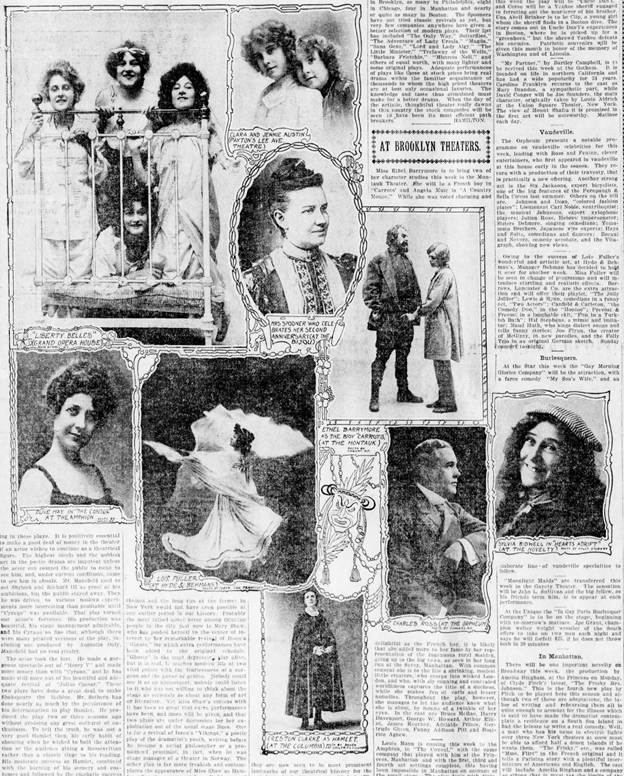






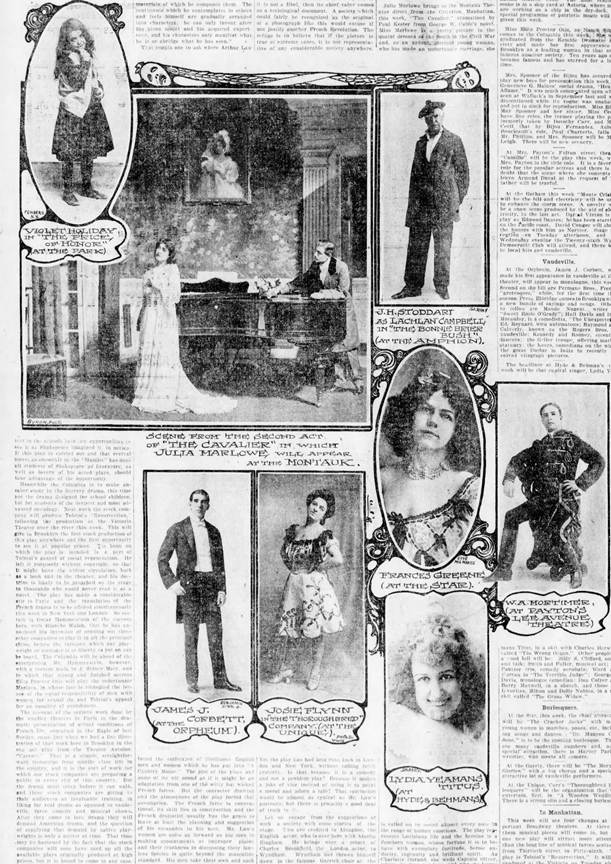
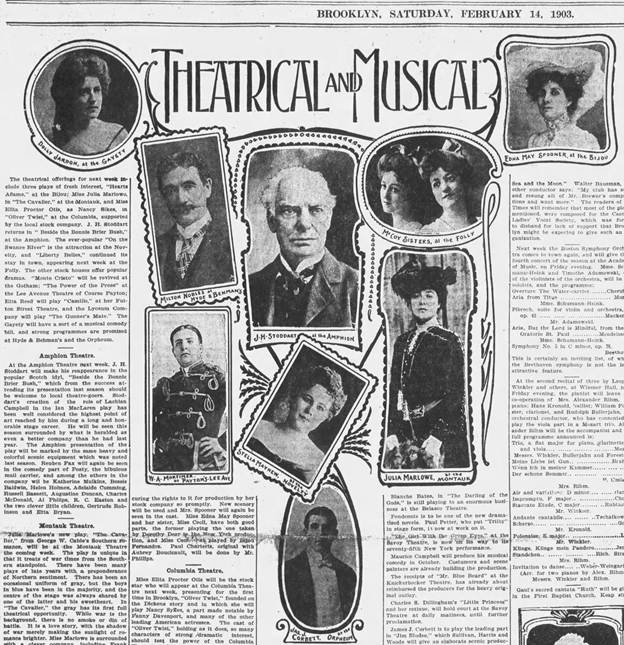
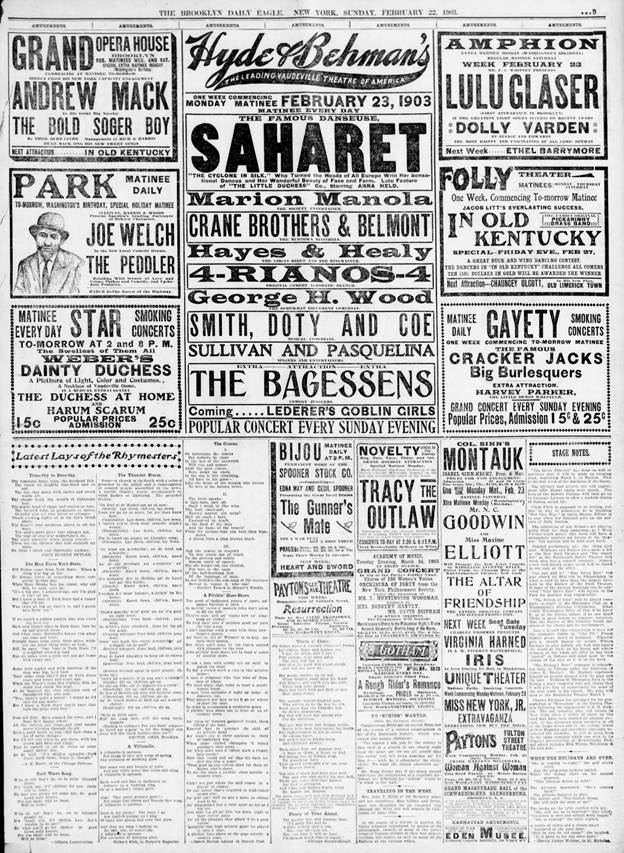


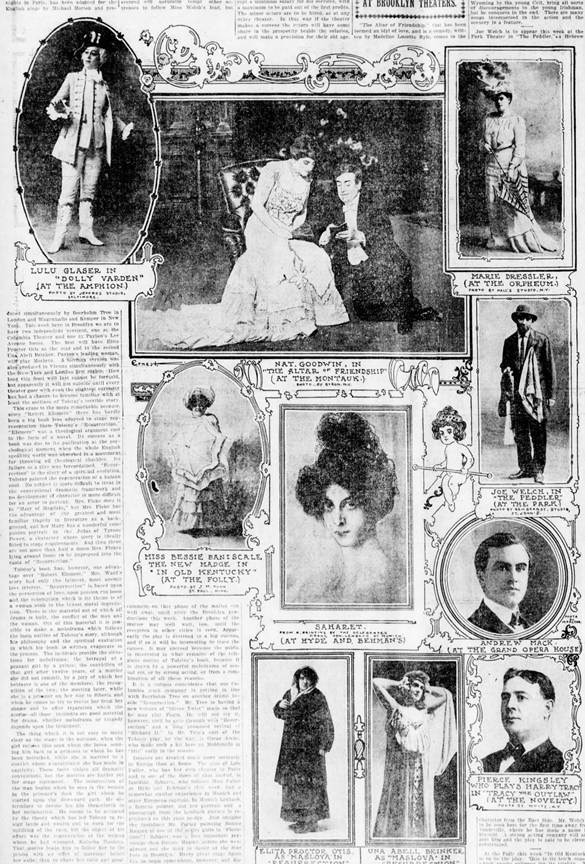




No comments:
Post a Comment